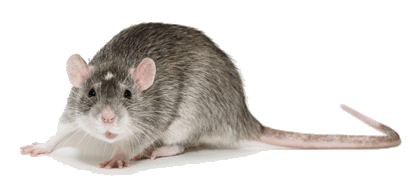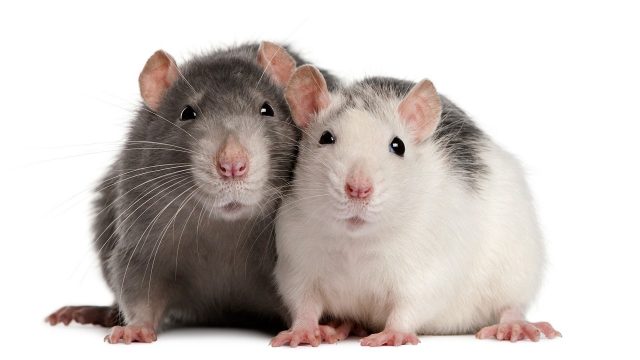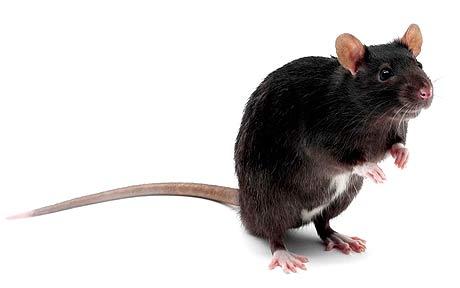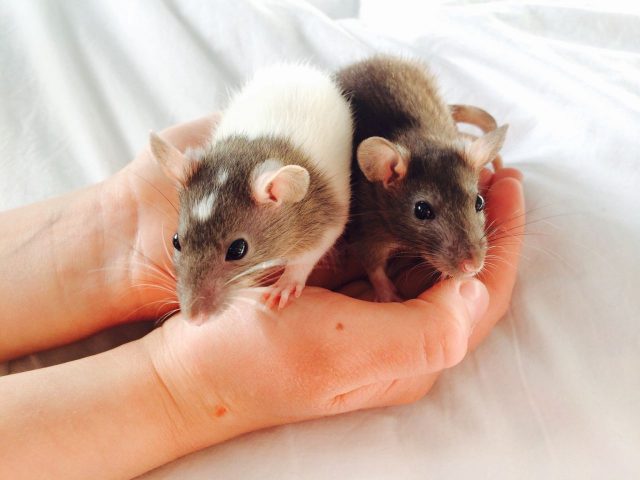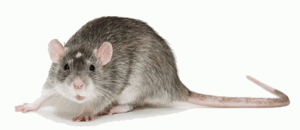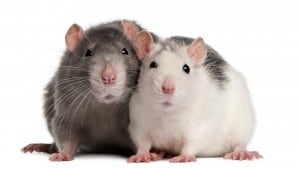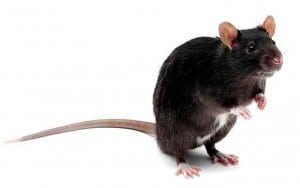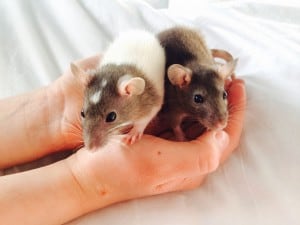Type the name of the breed you're looking for below
[wpdreams_ajaxsearchlite] Don't see the breed your're looking for? Click here and let us know!Fancy Rat
| Origin | The fancy rat is a domesticated brown rat (Rattus norvegicus), which is the most common type of pet rat. The name fancy rat derives from the idea of animal fancy or the phrase "to fancy" (to like, or appreciate). Fancy rats have their origins as the targets for blood sport in 18th- and 19th-century Europe. Specially bred as pets since then, fancy rats now come in a wide variety of colours and coat types and there exists several rat fancier groups worldwide. Fancy rats are commonly sold as pets in stores and by breeders. Domesticated rats are physiologically and psychologically different from their wild relatives, and, when acquired from reputable breeders and shops, they pose no more of a health risk than other common pets. For example, domesticated brown rats are not considered a plague threat, while exposure to wild rat populations could introduce pathogens like Salmonella into the home. Fancy rats experience different health risks from their wild counterparts, and thus are less likely to succumb to many of the same illnesses as wild rats. |
| Natural Habitat | Likely originating from the plains of Asia, northern China and Mongolia, the brown rat spread to other parts of the world sometime in the Middle Ages. The question of when brown rats became commensal with humans remains unsettled, but as a species, they have spread and established themselves along routes of human migration and now live almost everywhere humans are. The brown rat may have been present in Europe as early as 1553, a conclusion drawn from an illustration and description by Swiss naturalist Conrad Gesner in his book Historiae animalium, published 1551–1558. Though Gesner's description could apply to the black rat, his mention of a large percentage of albino specimens—not uncommon among wild populations of brown rats—adds credibility to this conclusion. Reliable reports dating to the 18th century document the presence of the brown rat in Ireland in 1722, England in 1730, France in 1735, Germany in 1750, and Spain in 1800, becoming widespread during the Industrial Revolution. It did not reach North America until around 1750–1755. As it spread from Asia, the brown rat generally displaced the black rat in areas where humans lived. In addition to being larger and more aggressive, the change from wooden structures and thatched roofs to bricked and tiled buildings favored the burrowing brown rats over the arboreal black rats. In addition, brown rats eat a wider variety of foods, and are more resistant to weather extremes. In the absence of humans, brown rats prefer damp environments, such as river banks.However, the great majority are now linked to man-made environments, such as sewage systems. |
| Wild Species | The brown rat, also referred to as common rat, street rat, sewer rat, Hanover rat, Norway rat, brown Norway rat, Norwegian rat, or wharf rat (Rattus norvegicus) is one of the best known and most common rats. One of the largest muroids, it is a brown or grey rodent with a body up to 25 cm (10 in) long, and a similar tail length; the male weighs on average 350 g (12 oz) and the female 250 g (9 oz). Thought to have originated in northern China, this rodent has now spread to all continents except Antarctica, and is the dominant rat in Europe and much of North America—making it by at least this particular definition the most successful mammal on the planet after humans. With rare exceptions, the brown rat lives wherever humans live, particularly in urban areas. Selective breeding of Rattus norvegicus has produced the laboratory rat, a model organism in biological research, as well as pet rats. |
| History with Humans | The origin of the modern fancy rat begins with the rat-catchers of the 18th and 19th centuries who trapped rats throughout Europe. These rat-catchers would then either kill the rats, or, more likely, sell the rats to be used in bloodsport. Rat-baiting was a popular sport until the beginning of the 20th century. It involved filling a pit with several rats and then placing bets on how long it would take a terrier to kill them all. It is believed that both rat-catchers and sportsmen began to keep certain, odd-coloured rats during the height of the sport, eventually breeding them and then selling them as pets. The two men thought to have formed the basis of rat fancy are Jack Black, rat-catcher to Queen Victoria, and Jimmy Shaw, manager of one of the largest sporting public houses in London. These two men are responsible for beginning many of the colour varieties present today. Black, specifically, was known for taming the "prettier" rats of unusual colour, decorating them with ribbons, and selling them as pets. It was not uncommon in upper circles of Victorian England to see a lady with her pet rat on a short monkey leash sitting on her lap, grandly festooned with ribbons. Rat fancy as a formal, organised hobby began when a woman named Mary Douglas asked for permission to bring her pet rats to an exhibition of the National Mouse Club at the Aylesbury Town Show in England on October 24, 1901. Her black-and-white hooded rat won "Best in Show" and ignited interest in the area. After Douglas' death in 1921, rat fancy soon began to fall back out of fashion. The original hobby formally lasted from 1912 to 1929 or 1931, as part of the National Mouse and Rat Club, at which point Rat was dropped from the name, returning it to the original National Mouse Club. The hobby was revived in 1976 with the formation of the English National Fancy Rat Society (NFRS). Pet rats are now commonly available in stores and from breeders, and there exist several rat fancier groups worldwide. |
| As Pets | While domesticated rats are not removed enough from their wild counterparts to justify a distinct subspecies (compare Canis lupus familiaris), there are significant differences that set them apart; the most apparent is colouring. Random colour mutations may occur in the wild, but these are rare. Most wild R. norvegicus are a dark brown colour, while fancy rats may be anything from white to cinnamon to blue. Behaviorally, domesticated pet rats are tamer than those in the wild. They are more comfortable around humans, known to seek out their owners while roaming freely. They have decreased reactions to light and sound, are less wary of new foods, and have better tolerance to overcrowding. Fancy rats are shown to mate earlier, more readily, and for a longer period of time over their lifespan. Also, domesticated rats exhibit different behaviors when fighting with each other; while wild rats almost always flee a lost battle, caged rats spend protracted amounts of time in a belly-up or boxing position. These behavioral traits are thought to be products of environment as opposed to genetics. However, it is also accepted that there are certain underlying biological reasons for why some members of a wild species are more receptive to domestication than others, and that these differences are then passed down to offspring (compare Domesticated silver fox). Domesticated rats have a longer lifespan than that of wild rats. Because domesticated rats are protected from predators and have ready access to food, water, shelter, and medical care, their average lifespan is around two to three years, in contrast to wild R. norvegicus which average a lifespan of less than one year. However, wild rats generally have larger brains, hearts, livers, kidneys, and adrenal glands than laboratory rats. The fancy rat and wild rat also both face a multitude of differing health concerns; the former is at risk of developing a pneumococcal infection from exposure to humans, while the latter may harbour tapeworms after coming in contact with carriers like cockroaches and fleas. |
| Colour Variations | As in other pet species, a variety of colours, coat types, and other features that do not appear in the wild have either been developed, or have appeared spontaneously. Any individual rat may be defined one or more ways by its colour, coat, marking, and non-standard body type. This allows for very specific classifications such as a ruby-eyed, cinnamon, Berkshire, rex, and Dumbo. Colouring: While some pet rats retain the agouti colouring of the wild brown rat (three tones on the same hair), others may solid colours (a single colour on each hair), a trait derived from the black rat. Agouti-based colours include agouti, cinnamon, and fawn. Black-based colours include black, beige, and chocolate. Eye colour is considered a subset of colouring, and coat colour definitions often include standards for the eyes, as many genes which control eye colour will also affect the coat colour or vice versa. The American Fancy Rat and Mouse Association (AFRMA) lists black, pink, ruby, and odd-eyed (two different-coloured eyes) as possible eye colours, depending on the variety of rat shown. Ruby refers to eyes which at a glance appear black but which are on closer observation a deep, dark red. Colour names can vary for more vaguely defined varieties, like lilac and fawn, while the interpretations of standards can fluctuate between (and even within) different countries or clubs. Markings: Himalayan rats have a unique colour and marking variation. Further dividing the varieties of fancy rats are the many different markings. Pet rats can appear in any combination of colours and markings. The markings are typically in reference to the patterns and ratios of coloured hair versus white hair. Two extremes would be a self (completely solid, non-white colour) and a Himalayan (completely white except blending into coloured areas at the nose and feet, called points, as in a Himalayan cat's markings). Markings have a strict standard, with detailed terminology, for showing in fancy rat pet shows. However, many domestic rats are not closely bred to any colour standard; many of those found in pet shops will have mismarkings from a formal breeding perspective, which are defined as variations in markings that are not recognised as conforming to a breed standard published by a rat fancier organisation. Commonly recognised standards include: Berkshire – coloured top, white belly Hooded – colour runs in a saddle, a single, unbroken line from full head down the spine and possibly partly down the tail Capped – colour on full head only Variegated – a blaze, or short white strip on the forehead, with a fully coloured head, and splotches or flecks of colour run down the back only Irish or English Irish – In England, the Irish is standardised by the NFRS as an equilateral triangle of white with a side that begins at the chest, or between the front legs, and where the point ends mid length. In the United States and elsewhere, clubs like the AFRMA distinguish this marking as the English Irish and allow for another standardised Irish in which the rat may have white of an even or symmetrical nature anywhere along its underside. Other marking varieties include spotted or Dalmatian (named for the spotted Dalmatian dog), blazed, masked, and Siamese (typically a gradient of colour along the body, darkest at the base of the tail and nose as in Siamese cats), and downunder or downunders (an Australian variety which has a solid colour stripe on the belly or a colour marking there that corresponds to markings on top). Body type: Two of the most prominent and standardised physical changes applied to rats through selective breeding are the development of the Manx and Dumbo. The Dumbo, whose origins are in the United States, is characterised by having large, low, round ears on the sides of its head, and was named for resemblance to the fictional Dumbo the elephant. The Manx rat is tailless due to a genetic mutation, and was named for the Manx cat, which shares this feature, though not necessarily due to the same mutation. Coat types: There is a relatively small variety of coats in relation to the number of colours and markings, and not all are internationally standardised. The most common type is the normal or standard, which is allowed variance in coarseness between the sexes; males have a coarse, thick, rough coat, while females' coats are softer and finer. Other standardised coats include: rex, in which all the hairs are curly, even the whiskers; velveteen, a softer variation of the rex; satin or silky coat, which is extra-soft and fine, with a sheen; and Harley, characterised by wispy long straight hairs. Remaining coat types are not defined by the hair itself, but rather by the lack of it, such as hairless rats. Hairless rats: Hairless rats are a coat variety characterised by varying levels of hair loss. Hairless rats, bred from curly-coated rexes, range from having areas of very short fur to being completely bare. Hairless rats are genetically produced by breeding different combinations of the genes that cause Rex coats. Since rex is a dominant trait, there only needs to be one rex parent to produce curly rex-coated offspring. However, when two copies of the trait are present, by breeding two rexes together, the coat is affected differently—causing hairlessness, and earning the colloquial name, "double-rex". One subset of semi-hairless rats, Patchwork rats, constantly lose hair and regrow it in different "patches" several times throughout their life. Ethics of selective breeding: There is controversy among rat fanciers in regard to selective breeding. On one hand, breeding rats to "conform" to a specific standard or to develop a new one is a large part of what the fancy was founded on. On the other hand, the process results in many rats who do not "conform", and are then either given away, sold as food, or killed—referred to as culling. There are concerns as to whether breeding hairless and tailless rats is ethical. The tail is vital for rats' balance and for adjusting body temperature. Tailless rats have greater risk of heat exhaustion, poor bowel and bladder control, falling from heights, and can be at risk for life-threatening deformities in the pelvic region like hind leg paralysis and megacolon. Similarly, hairless rats are less protected from scratches and the cold without their coat. Groups such as the NFRS prohibit the showing of these varieties at their events and forbid advertisement through affiliated services. Availability: Because R. norvegicus and related species are seen as pests, their intentional import into foreign countries is often regulated. For example, the importation of foreign rodents is prohibited in Australia, and so various coat types, colours, and varieties have been bred separately from foreign lines, or are just not obtainable within that country. In other areas, like the Canadian province of Alberta, which is considered rat-free, the ownership of domestic fancy rats outside of schools, laboratories, and zoos is illegal. |
| Care | Remove droppings, uneaten food and soiled areas of bedding from your pets’ cage every day. Clean the cage completely once a week by replacing dirty bedding and scrubbing down the rest of the cage with warm, soapy water. Rats are friendly and curious by nature, but you’ll need to get your pets used to you—and used to being handled. Start by feeding them small treats. When they’re comfortable with that, you can pick them up, one hand supporting the bottom, the other over the back. When you get to know each other better, don’t be surprised if your little friends want to snuggle and be petted. Once your rats are hand-tamed, you should let them play outside of the cage in a safe, secure area for an hour or so every day. This out-of-cage playtime is mandatory—and will keep your smart, active friends mentally stimulated and physically fit. Just be sure to supervise at all times, please. |
| Bath Requirements | Rats are clean animals that normally keep their coats clean themselves. It is necessary to wash them very often but when you do, make sure that you use a neutral pH shampoo and then rub the animal thoroughly dry. |
| Housing | Rats are very social with members of their own kind, and should be kept in pairs at minimum. Baby rats can be removed from their litters at about six weeks of age. A pair of females is recommended for first-time rat caretakers. Males can do well together if introduced when they are young. Females, on the other hand, are more accepting of new friends introduced later in life. Note that a neutered male can live with females, or a spayed female can live with males. Do not keep intact males and females together, as they will breed—and breed. The average rat litter is 12 young, and can be as high as 20. Rats do best in wire cages because they enjoy climbing, and the wire offers good ventilation. A cage that is 2’ x 2’ x 2’ (60 cm x 60 cm x 60 cm) will generally do for a pair of rats, but a larger space would be much appreciated. If you plan to keep more than that, you’ll need a larger cage. The floor should be solid, and a bedding of aspen or pelleted recycled paper must be provided. Do not use pine or cedar shavings, which can be harmful to your pets. If you find that your rats like to make nests, provide shredded paper towels or napkins for this purpose. A large, multi-level cage designed for ferrets can also make a great rat home, as can a large aquarium. If you opt for the latter, you’ll need a screen cover to provide ventilation, and will probably need to clean the cage more often to keep odor problems under control. Whatever type of cage you choose, don’t forget the furniture! Provide small boxes or flower pots to hide in (it’s very necessary for your rats to have a quiet place to which they can retreat) and PVC tubes for your rats to run through. You can also add a tree branch for them to climb on. Some rats enjoy running on an exercise wheel, so you may want to get yours one. Make sure that the wheel has a solid surface without wire rungs, so their tails cannot get caught while running. Keep in mind that a bored rat is an unhappy rat, and it’s up to you to provide the fun and games for your little guys. They LOVE toys, and you can offer yours many of the same toys that are enjoyed by parrots, including swings and ropes for climbing. Rats can be prone to colds, so be sure to keep the cage out of drafts. Intense direct sunlight should also be avoided, as rats are highly susceptible to heatstroke. A room kept at 60 to 80 degrees Fahrenheit (21 degrees Celsius) should be just right. Make sure the cage is easily accessible for clean-up by placing it away from the wall. (And P.S., it’s especially great if you can find a location where the family gathers in the early evening—your gregarious pets will love it!) |
| Health | Human-raised R. norvegicus are more prone to specific health risks and diseases than their wild counterparts, but they are also far less likely to succumb to certain illnesses that are prevalent in the wild. The major considerations for susceptibility include exposure, living conditions, and diet. Rats that live their entire lives indoors usually are able to avoid disease-causing bacteria such as Salmonella and Pseudomonas aeruginosa; the latter is absent in treated water. They may also more easily avoid vectors like cockroaches, beetles, and fleas which are essential for the spread of endemic typhus and intestinal parasites like the Rat tapeworm. Additionally, pet or laboratory rats enjoy the intrinsic benefits of having a consistent and well-balanced diet, along with access to medical care. Pet rats can also develop pituitary tumors if they are given high-calorie diets, and ringtail if they are placed in areas with low humidity or high temperatures. Staphylococcus spp. are a mostly benign group of bacteria that commonly reside on the top of the skin, but cuts and scratches from social and hierarchal fighting can open up the pathways for them to cause ulcerative dermatitis. Risks to owners: Keeping rats as pets can come with the stigma that rats supposedly transmit dangerous diseases to their owners. One fear is that all rats carry plague, when in fact R. norvegicus is not among the list of species considered a threat. In 2004, an outbreak of salmonella in the United States was connected to people who owned pet rats. However, it has been determined that a pet rat's initial exposure to salmonella, along with many other zoonotic rat-diseases, typically indicates exposure to wild rodent populations, either from an infestation in the owner's home, or from the pet's contaminated food, water, or bedding. |
| Diet | The brown rat is a true omnivore and will consume almost anything, but cereals form a substantial part of its diet. Martin Schein, founder of the Animal Behavior Society in 1964, studied the diet of brown rats and came to the conclusion that the most-liked foods of brown rats include scrambled eggs, macaroni and cheese, and cooked corn kernels. According to Schein, the least-liked foods were raw beets, peaches, and raw celery. Foraging behavior is often population-specific, and varies by environment and food source. Brown rats living near a hatchery in West Virginia catch fingerling fish. Some colonies along the banks of the Po River in Italy will dive for mollusks, a practice demonstrating social learning among members of this species. Rats on the island of Norderoog in the North Sea stalk and kill sparrows and ducks. Your pets’ main diet should consist of rat blocks, a high-quality pellet chow formulated for rodents. Look for a brand that lists soy meal as the main ingredient. This food should be available at all times. It is recommends offering small amounts of fresh fruits and vegetables to your rats every day. Peas, broccoli, carrots, apples and bananas are good foods to start with, but it’s fun to try new things and find out your pets’ favorites. Rats love people food, and you can give yours the occasional table scrap, such as cooked pasta, small pieces of egg or chicken, or a bit of pizza crust. Treats need to be limited to prevent obesity. Do not give your rats chocolate, corn, candy, caffeinated and carbonated beverages, onions, sticky foods such as taffy and peanut butter, and junk food. Fresh, clean water should be available at all times. A water bottle with a drinking tube that attaches to the side of the cage is the best way to go. |
| Dentistry | Like that of all rodents, a rat’s front teeth grow continuously. Provide unpainted, untreated pieces of wood, dog biscuits or safe cardboard or rawhide chew toys for your rats to gnaw on. This is crucial for keeping their teeth in tip-top condition and preventing dental problems. |
| Infectious Diseases | While living indoors decreases the risk of contracting certain diseases, living in close quarters with other rats, being unable to always seek proper protection from environmental factors (e.g. temperature, humidity), being fed an unhealthy diet, and the stresses inherently associated with living in an unnatural habitat can all adversely affect a rat's health to make them more prone to specific conditions. Specifically, Tyzzer's disease, protozoic infections (e.g. Giardia muris), and pseudotuberculosis are usually seen in stressed or young rats. Additionally, pet rats are exposed to Streptococcus pneumoniae, a zoonotic disease caught from humans, not the same bacteria associated with strep throat. A human-associated fungus, Pneumocystis carinii (also found in almost all domesticated animals) is usually asymptomatic in the rat, unless the rat's immune system is compromised by illness. If this occurs the infection can develop into pneumonia. Several diseases, like Rat Coronavirus Infection (RCI), Sendai virus, and Murine Respiratory Mycoplasmosis (MRM, Mycoplasma pulmonis), are prevalent simply because their highly contagious natures work in tandem with the way rats are kept in laboratories, pet stores, and by breeders. It should be noted, however, that MRM is far less likely to occur in laboratory rats than in those kept as pets. |
| Mental Health | Social behavior: Particularly with males, there can be some fighting in the beginning, but once an alpha rat has been determined, the rats should get along well. Within two weeks to a month, the rats will most likely have adjusted and become friendlier with each other. Rats are generally very friendly to other cage mates, particularly with females. They will even sometimes help or take care of other sick rats. Generally when two or more rats from the same litter are of the same sex they live together with no disruptions but with the occasional friendly tussle and play fight. Although it is possible that rats from different litters can be integrated together, the integration process can be easy or hard. Several measures have to be taken to provide security for both rats. Techniques for integration include bringing them to neutral ground so they do not become territorial. Unless there is an issue integrating rats together, owners often house rats in pairs, as they are very sociable creatures, and can entertain each other. |

